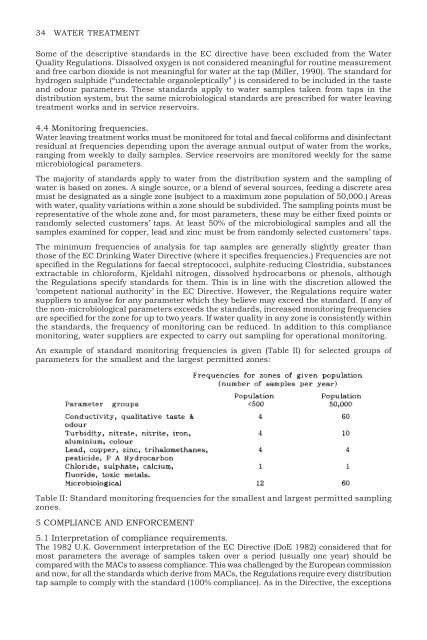Advances in Water Treatment and Enviromental Management
Advances in Water Treatment and Enviromental Management
Advances in Water Treatment and Enviromental Management
Create successful ePaper yourself
Turn your PDF publications into a flip-book with our unique Google optimized e-Paper software.
34 WATER TREATMENTSome of the descriptive st<strong>and</strong>ards <strong>in</strong> the EC directive have been excluded from the <strong>Water</strong>Quality Regulations. Dissolved oxygen is not considered mean<strong>in</strong>gful for rout<strong>in</strong>e measurement<strong>and</strong> free carbon dioxide is not mean<strong>in</strong>gful for water at the tap (Miller, 1990). The st<strong>and</strong>ard forhydrogen sulphide (“undetectable organoleptically” ) is considered to be <strong>in</strong>cluded <strong>in</strong> the taste<strong>and</strong> odour parameters. These st<strong>and</strong>ards apply to water samples taken from taps <strong>in</strong> thedistribution system, but the same microbiological st<strong>and</strong>ards are prescribed for water leav<strong>in</strong>gtreatment works <strong>and</strong> <strong>in</strong> service reservoirs.4.4 Monitor<strong>in</strong>g frequencies.<strong>Water</strong> leav<strong>in</strong>g treatment works must be monitored for total <strong>and</strong> faecal coliforms <strong>and</strong> dis<strong>in</strong>fectantresidual at frequencies depend<strong>in</strong>g upon the average annual output of water from the works,rang<strong>in</strong>g from weekly to daily samples. Service reservoirs are monitored weekly for the samemicrobiological parameters.The majority of st<strong>and</strong>ards apply to water from the distribution system <strong>and</strong> the sampl<strong>in</strong>g ofwater is based on zones. A s<strong>in</strong>gle source, or a blend of several sources, feed<strong>in</strong>g a discrete areamust be designated as a s<strong>in</strong>gle zone (subject to a maximum zone population of 50,000.) Areaswith water, quality variations with<strong>in</strong> a zone should be subdivided. The sampl<strong>in</strong>g po<strong>in</strong>ts must berepresentative of the whole zone <strong>and</strong>, for most parameters, these may be either fixed po<strong>in</strong>ts orr<strong>and</strong>omly selected customers’ taps. At least 50% of the microbiological samples <strong>and</strong> all thesamples exam<strong>in</strong>ed for copper, lead <strong>and</strong> z<strong>in</strong>c must be from r<strong>and</strong>omly selected customers’ taps.The m<strong>in</strong>imum frequencies of analysis for tap samples are generally slightly greater thanthose of the EC Dr<strong>in</strong>k<strong>in</strong>g <strong>Water</strong> Directive (where it specifies frequencies.) Frequencies are notspecified <strong>in</strong> the Regulations for faecal streptococci, sulphite-reduc<strong>in</strong>g Clostridia, substancesextractable <strong>in</strong> chloroform, Kjeldahl nitrogen, dissolved hydrocarbons or phenols, althoughthe Regulations specify st<strong>and</strong>ards for them. This is <strong>in</strong> l<strong>in</strong>e with the discretion allowed the‘competent national authority’ <strong>in</strong> the EC Directive. However, the Regulations require watersuppliers to analyse for any parameter which they believe may exceed the st<strong>and</strong>ard. If any ofthe non-microbiological parameters exceeds the st<strong>and</strong>ards, <strong>in</strong>creased monitor<strong>in</strong>g frequenciesare specified for the zone for up to two years. If water quality <strong>in</strong> any zone is consistently with<strong>in</strong>the st<strong>and</strong>ards, the frequency of monitor<strong>in</strong>g can be reduced. In addition to this compliancemonitor<strong>in</strong>g, water suppliers are expected to carry out sampl<strong>in</strong>g for operational monitor<strong>in</strong>g.An example of st<strong>and</strong>ard monitor<strong>in</strong>g frequencies is given (Table II) for selected groups ofparameters for the smallest <strong>and</strong> the largest permitted zones:Table II: St<strong>and</strong>ard monitor<strong>in</strong>g frequencies for the smallest <strong>and</strong> largest permitted sampl<strong>in</strong>gzones.5 COMPLIANCE AND ENFORCEMENT5.1 Interpretation of compliance requirements.The 1982 U.K. Government <strong>in</strong>terpretation of the EC Directive (DoE 1982) considered that formost parameters the average of samples taken over a period (usually one year) should becompared with the MACs to assess compliance. This was challenged by the European commission<strong>and</strong> now, for all the st<strong>and</strong>ards which derive from MACs, the Regulations require every distributiontap sample to comply with the st<strong>and</strong>ard (100% compliance). As <strong>in</strong> the Directive, the exceptions
















